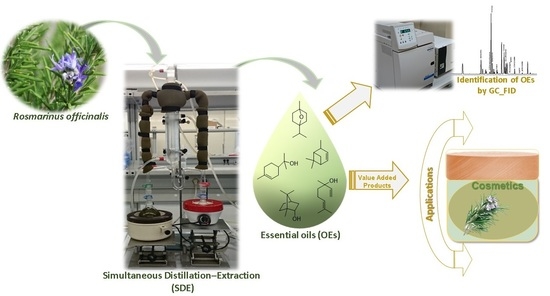Simultaneous Distillation–Extraction of Essential Oils from Rosmarinus officinalis L.
Abstract
:1. Introduction
2. Experimental
2.1. Chemicals
2.2. Sample
2.3. Apparatus and Material
2.4. Extraction
3. Method Optimization and Validation
4. Results and Discussion
5. Conclusions
Author Contributions
Funding
Institutional Review Board Statement
Informed Consent Statement
Data Availability Statement
Conflicts of Interest
References
- Flamini, G.; Cioni, P.L.; Morelli, I.; Macchia, M.; Ceccarini, L. Main agronomic-productive characteristics of two ecotypes of Rosmarinus officinalis L. and chemical composition of their essential oils. J. Agric. Food Chem. 2002, 50, 3512–3517. [Google Scholar] [CrossRef] [PubMed]
- Ali, M.S.; Saleem, M.; Ali, Z.; Ahmad, V.U. Chemistry of Zataria multiflora (Lamiaceae). Phytochemistry 2000, 55, 933–936. [Google Scholar]
- Begum, A.; Sandhya, S.; Ali, S.S.; Vinod, K.R.; Reddy, S.; Banji, D. An in-depth review on the medicinal flora Rosmarinus officinalis (Lamiaceae). Acta Sci. Pol. Technol. Aliment. 2013, 12, 61–73. [Google Scholar] [PubMed]
- Liu, T.; Sui, X.; Zhang, R.; Yang, L.; Zu, Y.; Zhang, L.; Zhang, Y.; Zhang, Z. Application of ionic liquids based microwave-assisted simultaneous extraction of carnosic acid, rosmarinic acid and essential oil from Rosmarinus officinalis. J. Chromatogr. A 2011, 1218, 8480–8489. [Google Scholar] [CrossRef]
- Yosr, Z.; Hnia, C.; Rim, T.; Mohamed, B. Changes in essential oil composition and phenolic fraction in Rosmarinus officinalis L. var. typicus Batt. organs during growth and incidence on the antioxidant activity. Ind. Crop. Prod. 2013, 43, 412–419. [Google Scholar] [CrossRef]
- Ribeiro-Santos, R.; Carvalho-Costa, D.; Cavaleiro, C.; Costa, H.S.; Albuquerque, T.G.; Castilho, M.C.; Ramos, F.; Melo, N.R.; Sanches-Silva, A. A novel insight on an ancient aromatic plant: The rosemary (Rosmarinus officinalis L.). Trends Food Sci. Technol. 2015, 45, 355–368. [Google Scholar] [CrossRef]
- The European Comission. Comission Directive, 2010/67/EU of 20 October 2010 amending Directive 2008/84/EC laying down specific purity criteria on food additives other than colours and sweeteners. Off. J. Eur. Union 2010, 277, 17–26. [Google Scholar]
- Diass, K.; Brahmi, F.; Mokhtari, O.; Abdellaoui, S.; Hammouti, B. Biological and pharmaceutical properties of essential oils of Rosmarinus officinalis L. and Lavandula officinalis L. Mater. Today Proc. 2021, 45, 7768–7773. [Google Scholar] [CrossRef]
- Mangena, T.; Muyima, N.Y.O. Comparative evaluation of the antimicrobial activities of essential oils of Artemisia afra, Pteronia incana and Rosmarinus officinalis on selected bacteria and yeast strains. Lett. Appl. Microbiol. 1999, 28, 291–296. [Google Scholar] [CrossRef]
- Pourmortazavi, S.M.; Hajimirsadeghi, S.S. Supercritical fluid extraction in plant essential and volatile oil analysis. J. Chromatogr. A 2007, 1163, 2–24. [Google Scholar] [CrossRef]
- Carvalho, I.T.; Estevinho, B.N.; Santos, L. Application of microencapsulated essential oils in cosmetic and personal healthcare products–A review. Int. J. Cosmet. Sci. 2016, 38, 109–119. [Google Scholar] [CrossRef] [PubMed]
- Casanova, F.; Estevinho, B.N.; Santos, L. Preliminary studies of rosmarinic acid microencapsulation with chitosan and modified chitosan for topical delivery. Powder Technol. 2016, 297, 44–49. [Google Scholar] [CrossRef]
- Casanova, F.; Santos, L. Encapsulation of cosmetic active ingredients for topical application–A review. J. Microencapsul. 2016, 33, 1–17. [Google Scholar] [CrossRef]
- Szumny, A.; Figiel, A.; Gutiérrez-Ortíz, A.; Carbonell-Barrachina, A.A. Composition of rosemary essential oil (Rosmarinus officinalis) as affected by drying method. J. Food Eng. 2010, 97, 253–260. [Google Scholar] [CrossRef]
- Teruel, M.R.; Garrido, M.D.; Espinosa, M.C.; Linares, M.B. Effect of different format-solvent rosemary extracts (Rosmarinus officinalis) on frozen chicken nuggets quality. Food Chem. 2015, 172, 40–46. [Google Scholar] [CrossRef] [PubMed]
- Badreddine, B.S.; Olfa, E.; Samir, D.; Hnia, C.; Mohamed, B.J. Chemical composition of Rosmarinus and Lavandula essential oils and their insecticidal effects on Orgyia trigotephras (Lepidoptera, Lymantriidae). Asian Pac. J. Trop. Med. 2015, 8, 98–103. [Google Scholar] [CrossRef] [Green Version]
- da Cruz Francisco, J.; Sivik, B. Solubility of three monoterpenes, their mixtures and eucalyptus leaf oils in dense carbon dioxide. J. Supercrit. Fluids 2002, 23, 11–19. [Google Scholar] [CrossRef]
- Cassel, E.; Vargasa, R.M.F.; Martinez, N.; Lorenzo, D.; Dellacassa, E. Steam distillation modeling for essential oil extraction process. Ind. Crop. Prod. 2009, 29, 171–176. [Google Scholar] [CrossRef]
- Vicente, G.; Molina, S.; González-Vallinas, M.; García-Risco, M.R.; Fornari, T.; Reglero, G.; de Molina, A.R. Supercritical rosemary extracts, their antioxidant activity and effect on hepatic tumor progression. J. Supercrit. Fluids 2013, 79, 101–108. [Google Scholar] [CrossRef] [Green Version]
- Chaintreau, A. Simultaneous distillation–extraction: From birth to maturity. Flavour Fragr. J. 2001, 16, 136–148. [Google Scholar] [CrossRef]
- Teixeira, S.; Mendes, A.; Alves, A.; Santos, L. Simultaneous distillation–extraction of high-value volatile compounds from Cistus ladanifer L. Anal. Chim. Acta 2007, 584, 439–446. [Google Scholar] [CrossRef] [PubMed] [Green Version]
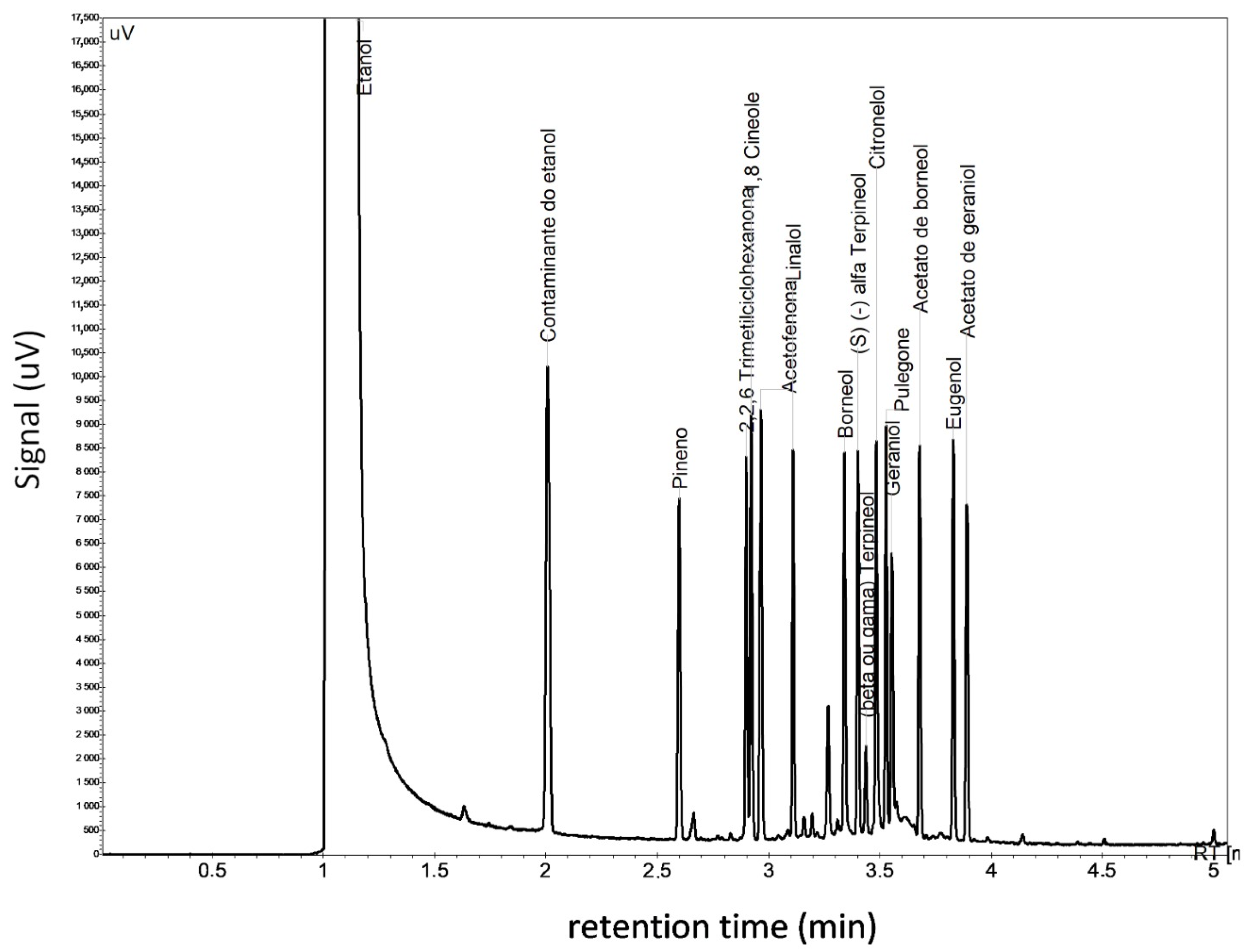
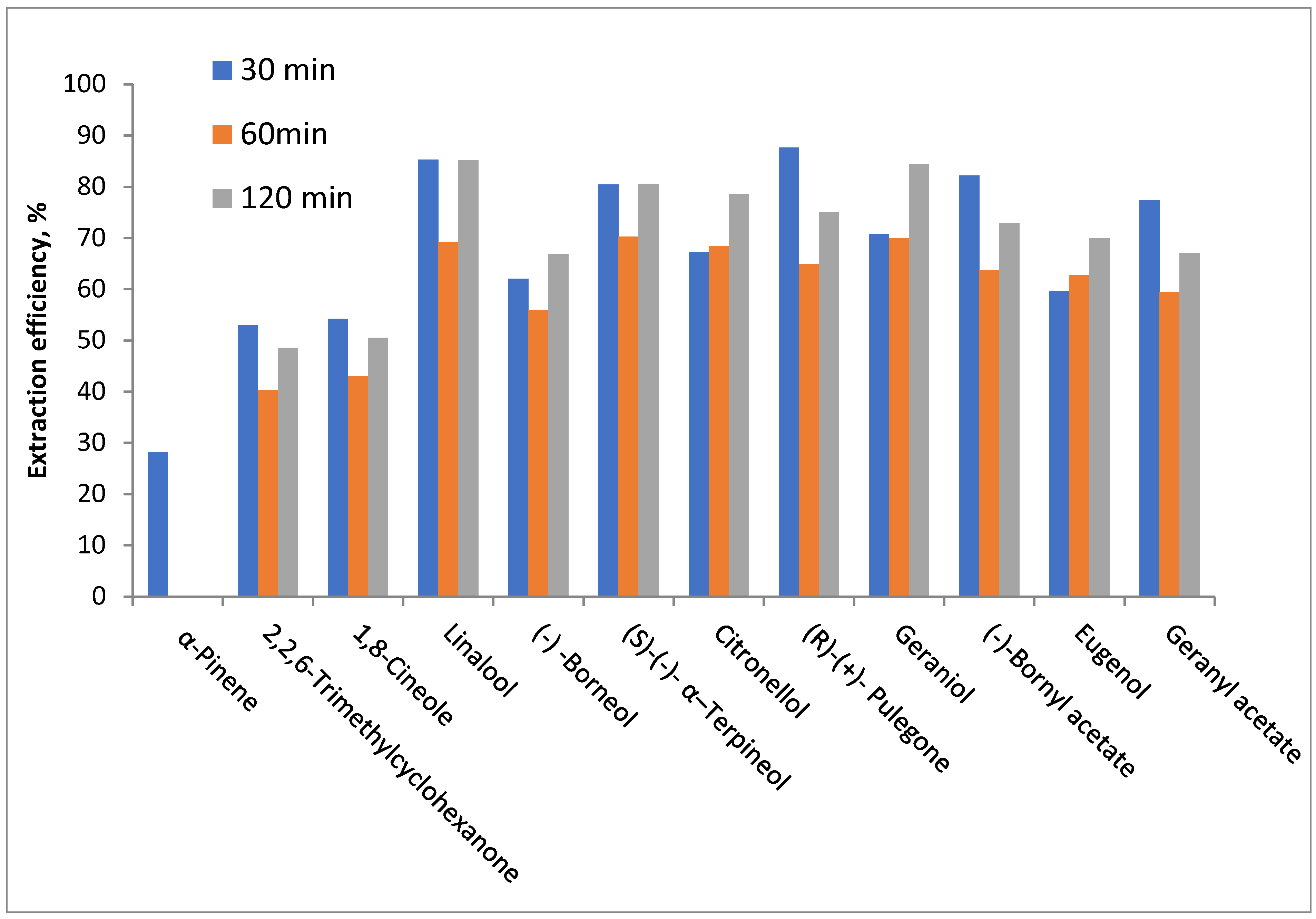
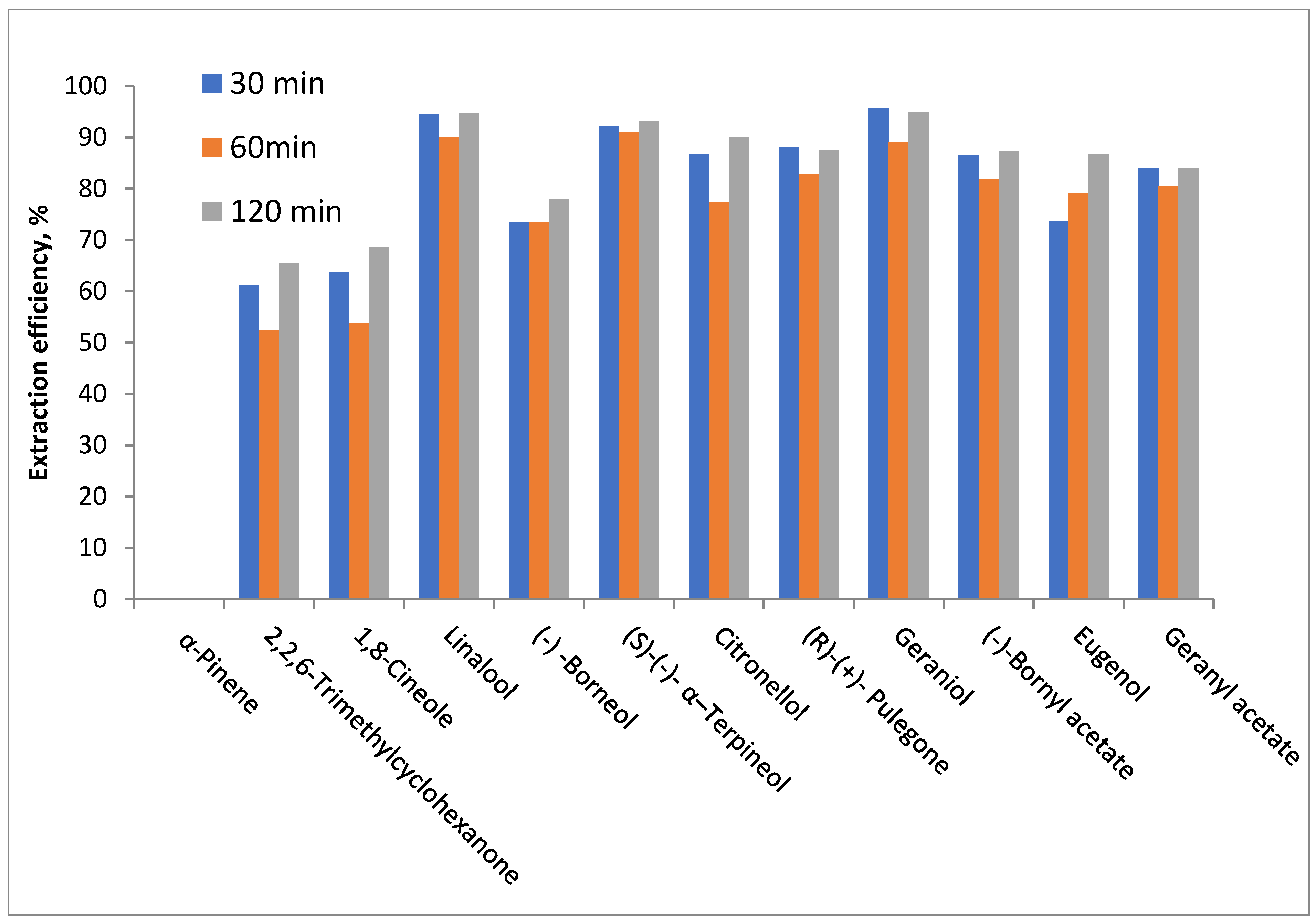

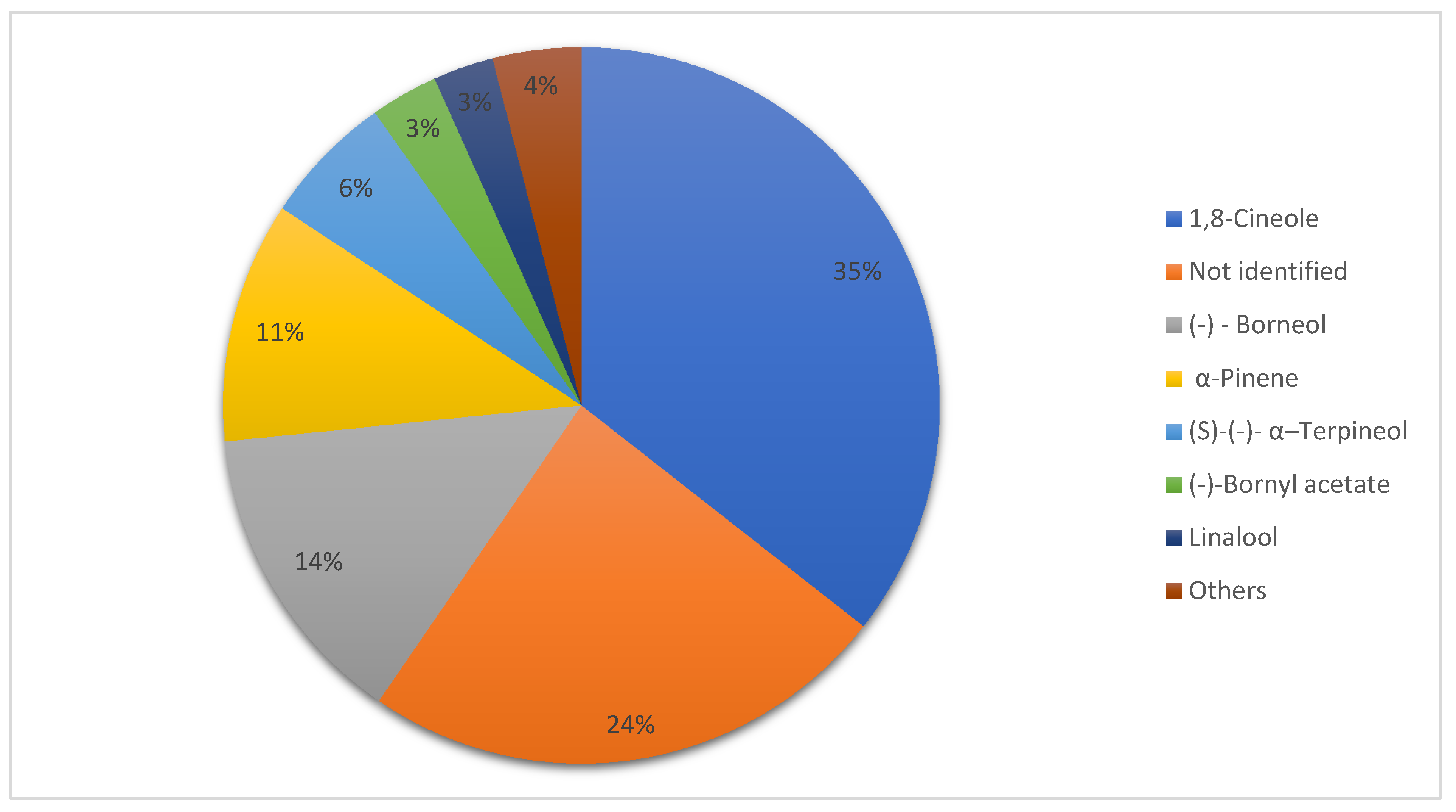
| Compound | CAHD | CAHD | CAHD | SFE |
|---|---|---|---|---|
| α-Pinene | 11.87 | 10.1 | 37.22 | - |
| 2,2,6-Trimethylcyclohexanone | NS | - | - | - |
| 1,8-Cineole | 34.82 | 35.8 | 23.76 | 48–67 |
| Linalool | 0.62 | 0.7 | 2.93 | - |
| (-) -Borneol | 5.09 | 9.2 | 0.80 | 6–15 |
| (S)-(-)-α–Terpineol | 4.12 | 4.4 | 1.51 | - |
| Citronellol | - | - | 0.18 | - |
| (R)-(+)- Pulegone | - | - | - | - |
| Geraniol | - | - | 2.94 | - |
| (-)-Bornyl acetate | 1.56 | 1.6 | 1.70 | 1–2 |
| Eugenol | - | - | - | - |
| Geranyl acetate | - | - | 0.22 | - |
| Reference | Badreddine et al., 2015 | Yosr et al., 2013 | Cassel et al., 2009 | Vicente et al., 2013 |
| Compound | Retention Time (min) | Concentration Range (mg/L) | Correlation Coefficient—(R2) |
|---|---|---|---|
| α-Pinene | 2.602 | 3.5–139.5 | 0.9993 |
| 2,2,6-Trimethylcyclohexanone | 2.899 | 0.9–36.8 | 0.9997 |
| 1,8-Cineole | 2.925 | 1.0–38.3 | 0.9996 |
| Acetophenone | 2.968 | 39.3 | Internal standard |
| Linalool | 3.110 | 0.9–36.6 | 0.9998 |
| (-) -Borneol | 3.345 | 0.9–36.1 | 0.9998 |
| (S)-(-)-α–Terpineol | 3.405 | 0.9–35.7 | 0.9998 |
| Citronellol | 3.479 | 1.0–39.0 | 0.9995 |
| (R)-(+)- Pulegone | 3.523 | 0.9–37.8 | 0.9997 |
| Geraniol | 3.553 | 0.8–33.0 | 0.9996 |
| (-)-Bornyl acetate | 3.683 | 0.9–35.9 | 0.9999 |
| Eugenol | 3.834 | 1.0–40.2 | 0.9992 |
| Geranyl acetate | 3.892 | 0.9–36.1 | 0.9986 |
| Compound | Extraction Efficiency Using n-Pentane (%) | |||||
|---|---|---|---|---|---|---|
| Day 1 | Day 2 | Day 3 | Day 4 | Average | RSD (%) | |
| α-Pinene | 23 | 24 | 38 | ND | 28 | 29 |
| 2,2,6-Trimethylcyclohexanone | 52 | 52 | 60 | 48 | 53 | 9 |
| 1,8-Cineole | 52 | 53 | 62 | 50 | 54 | 10 |
| Linalool | 93 | 95 | 88 | 65 | 85 | 16 |
| (-) -Borneol | 66 | 71 | 67 | 44 | 62 | 20 |
| (S)-(-)-α–Terpineol | 91 | 92 | 85 | 54 | 80 | 22 |
| Citronellol | 67 | 79 | 73 | 50 | 67 | 18 |
| (R)-(+)- Pulegone | 85 | 103 | 80 | 82 | 88 | 12 |
| Geraniol | 73 | 85 | 78 | 47 | 71 | 23 |
| (-)-Bornyl acetate | 85 | 87 | 79 | 78 | 82 | 6 |
| Eugenol | 75 | 70 | 66 | 28 | 60 | 35 |
| Geranyl acetate | 83 | 83 | 75 | 68 | 77 | 9 |
| Compound | Concentration (mg/kg) |
|---|---|
| α-Pinene | 3463.3 |
| 2,2,6-Trimethylcyclohexanone | 114.0 |
| 1,8-Cineole | 1615.0 |
| Linalool | 90.9 |
| (-)—Borneol | 531.8 |
| (S)-(-)-α–Terpineol | 195.5 |
| Citronellol | ND |
| (R)-(+)- Pulegone | 3.7 |
| Geraniol | 8.4 |
| (-)-Bornyl acetate | 100.6 |
| Eugenol | 7.0 |
| Geranyl acetate | 38.7 |
Publisher’s Note: MDPI stays neutral with regard to jurisdictional claims in published maps and institutional affiliations. |
© 2021 by the authors. Licensee MDPI, Basel, Switzerland. This article is an open access article distributed under the terms and conditions of the Creative Commons Attribution (CC BY) license (https://creativecommons.org/licenses/by/4.0/).
Share and Cite
Ribeiro, B.S.; Ferreira, M.d.F.; Moreira, J.L.; Santos, L. Simultaneous Distillation–Extraction of Essential Oils from Rosmarinus officinalis L. Cosmetics 2021, 8, 117. https://doi.org/10.3390/cosmetics8040117
Ribeiro BS, Ferreira MdF, Moreira JL, Santos L. Simultaneous Distillation–Extraction of Essential Oils from Rosmarinus officinalis L. Cosmetics. 2021; 8(4):117. https://doi.org/10.3390/cosmetics8040117
Chicago/Turabian StyleRibeiro, Bárbara Silva, Maria de Fátima Ferreira, José Luís Moreira, and Lúcia Santos. 2021. "Simultaneous Distillation–Extraction of Essential Oils from Rosmarinus officinalis L." Cosmetics 8, no. 4: 117. https://doi.org/10.3390/cosmetics8040117
APA StyleRibeiro, B. S., Ferreira, M. d. F., Moreira, J. L., & Santos, L. (2021). Simultaneous Distillation–Extraction of Essential Oils from Rosmarinus officinalis L. Cosmetics, 8(4), 117. https://doi.org/10.3390/cosmetics8040117





